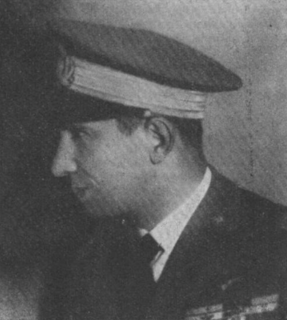Sottotenente Michele Allasia was a World War I fighter ace credited with five aerial victories.
Maggiore Sebastiano Bedendo was a World War I flying ace credited with five aerial victories. After completing his education postwar, he rejoined Italian military aviation. He set several world aviation flying records with a Nuvoli N.5 monoplane before dying in an air crash.
Sottotenente de Vascello Umberto Calvello was a World War I fighter ace credited with five victories.
Capitano Giulio Lega was a World War I flying ace credited with five aerial victories. After finishing the war, he completed medical school, and began a near lifelong career caring for the Italian Chamber of Deputies.
CapitanoGuido Masiero was a World War I flying ace credited with five confirmed and ten unconfirmed aerial victories. He was a prewar lancer who used his civilian engineering expertise to wrangle a transfer to aviation duty.

Amedeo Mecozzi was an Italian fighter ace of World War I, a general of the Italian Regia Aeronautica and a military theorist credited as the founding father of the "Attack air force" doctrine, which made him a strong opponent to general Giulio Douhet's theories.
Tenente ColonnelloGiorgio Michetti was a World War I flying ace credited with five aerial victories.
Tenente-colonnello Alessandro Resch was an Italian World War I flying ace credited with five confirmed aerial victories. After surviving World War I, he would become a pioneering airline captain, flying 500,000 miles between 1928 and 1935. He would return to the Italian Air Force as a major in 1935, rising to tenente-colonnello by 1939. His participation in World War II is unknown.

Sergente Maggiore Aldo Bocchese was a World War I flying ace credited with six aerial victories.

Tenente ColonnelloAlessandro Buzio was an Italian World War I flying ace credited with six aerial victories, four of them shared.
Sergente MaggioreAntonio Chiri was a World War I flying ace credited with six confirmed and seven unconfirmed aerial victories.
Tenente Luigi Olivi was an Italian World War I flying ace credited with six aerial victories. He won two awards of the Silver Medal for Military Valor and was killed in action.
Antonio Riva was an Italian pilot and a World War I flying ace, credited with seven confirmed and seven unconfirmed aerial victories. In 1951, he was executed by firing squad under the newly established People's Republic of China for allegedly conspiring to assassinate Mao Zedong and other Communist leaders.
Capitano Antonio Reali was an Italian World War I flying ace credited with eleven confirmed aerial victories, and 22 unconfirmed victories. He served in the Regia Aeronautica Reserves from 1923 to about 1940.

Kurt Gruber was an Austro-Hungarian flying ace during the First World War who held the rank of Offiziersstellvertreter. He was credited with eleven aerial victories, 5 shared with other pilots.
Oberleutnant Franz Rudorfer was an Austro-Hungarian World War I flying ace credited with eleven confirmed and two unconfirmed aerial victories.
SergenteGiovanni Nicelli was an Italian World War I flying ace. He was credited with eight or nine confirmed aerial victories, and died in service to his nation on 5 May 1918.
Flaminio Avet was a World War I flying ace credited with eight aerial victories. Although born in Nice, France, he served in the Italian military as Italy entered World War I. After a transfer from Lancers to aviation, he trained as a pilot. He began his aerial combat career on 27 November 1918, and would stake a dozen victory claims, eight of which would be verified. He ended the war having won the Silver Medal for Military Valor three times. He returned to Nice postwar, and died there on 21 August 1928.
CapitanoErnesto Cabruna (1889–1960) was a professional soldier who became a World War I flying ace credited with eight aerial victories. He served in Italy's military police, beginning in 1907. After service in Libya and Rhodes, he received a Bronze Medal for Military Valor a year after Italy's involvement in World War I began. He turned to aviation, became a pilot, and as such earned his first Silver Medal for Military Valor at the end of 1917.

78a Squadriglia was one of the original Italian fighter squadrons of World War I, serving in combat from 29 June 1916 to 3 November 1918. They flew 4,770 combat missions and were credited with 88 aerial victories.





